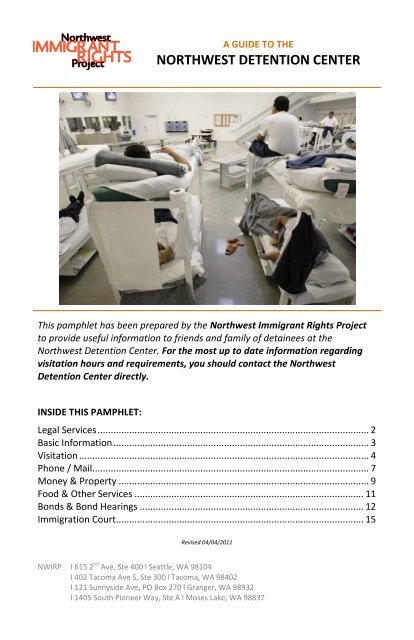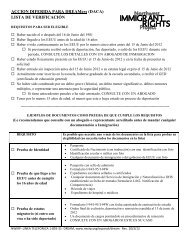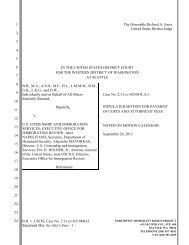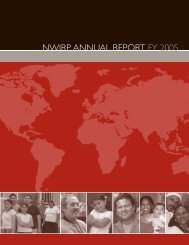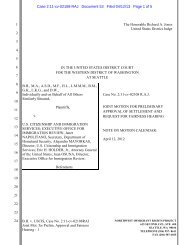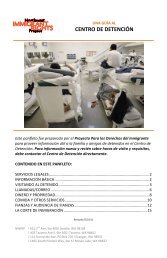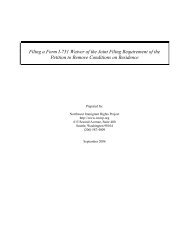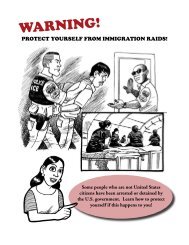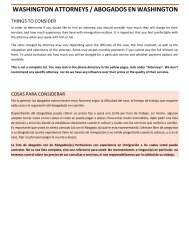A GUIDE TO THE - Northwest Immigrant Rights Project
A GUIDE TO THE - Northwest Immigrant Rights Project
A GUIDE TO THE - Northwest Immigrant Rights Project
You also want an ePaper? Increase the reach of your titles
YUMPU automatically turns print PDFs into web optimized ePapers that Google loves.
A <strong>GUIDE</strong> <strong>TO</strong> <strong>THE</strong><br />
NORTHWEST DETENTION CENTER<br />
This pamphlet has been prepared by the <strong>Northwest</strong> <strong>Immigrant</strong> <strong>Rights</strong> <strong>Project</strong><br />
to provide useful information to friends and family of detainees at the<br />
<strong>Northwest</strong> Detention Center. For the most up to date information regarding<br />
visitation hours and requirements, you should contact the <strong>Northwest</strong><br />
Detention Center directly.<br />
INSIDE THIS PAMPHLET:<br />
Legal Services ....................................................................................................... 2<br />
Basic Information ................................................................................................. 3<br />
Visitation .............................................................................................................. 4<br />
Phone / Mail......................................................................................................... 7<br />
Money & Property ............................................................................................... 9<br />
Food & Other Services ....................................................................................... 11<br />
Bonds & Bond Hearings ..................................................................................... 12<br />
Immigration Court.............................................................................................. 15<br />
Revised 04/04/2011<br />
NWIRP l 615 2 nd Ave, Ste 400 l Seattle, WA 98104<br />
l 402 Tacoma Ave S, Ste 300 l Tacoma, WA 98402<br />
l 121 Sunnyside Ave, PO Box 270 l Granger, WA 98932<br />
l 1405 South Pioneer Way, Ste A l Moses Lake, WA 98837
LEGAL SERVICES<br />
A pro se detainee is someone who does NOT have a lawyer and is representing<br />
themselves.<br />
If you know someone who has been detained at the <strong>Northwest</strong> Detention<br />
Center, is pro se, and needs legal assistance:<br />
Call the <strong>Northwest</strong> <strong>Immigrant</strong> <strong>Rights</strong> <strong>Project</strong> (NWIRP) at 253-383-0519<br />
or 877-814-6444;<br />
Leave the detainee’s name and A number (see below).<br />
Due to the volume of calls, NWIRP will not be able to return any calls. Please be<br />
assured that the detainee will be scheduled for a Legal Orientation <strong>Rights</strong><br />
Presentation as soon as possible. The detainee can also request to speak with<br />
one of NWIRP’s lawyers one-on-one after a presentation.<br />
Please note that most detainees will NOT be represented by NWIRP because<br />
there are too many pro se detainees. However, NWIRP will provide legal<br />
assistance to detainees as long as they are pro se.<br />
w w w . n w i rp. o rg P a g e | 2
BASIC INFORMATION<br />
Where is the NWDC?<br />
The NWDC is located in Tacoma, Washington, about 40 minutes south of<br />
Seattle. The address for the facility is 1623 East J Street, Tacoma, WA, 98421.<br />
Parking is available on the street in front of the NWDC.<br />
The NWDC is about 1.2 miles from the Tacoma Dome Bus Station, located at<br />
610 Puyallup Avenue, Tacoma, Washington.<br />
What is an “A” number?<br />
An “A” number is a 9-digit number assigned to non-citizens in the United States<br />
by the Department of Homeland Security. If the person detained did not have<br />
an A number prior to detention, one will be issued when they are processed<br />
into the detention center. This number is printed on all paperwork issued by<br />
the government regarding immigration, and can also be found on bracelets<br />
worn by detainees.<br />
w w w . n w i rp. o rg P a g e | 3
VISITATION<br />
How do I find out if someone is at the NWDC?<br />
If you have the full name and A number of the person you are looking for, you<br />
can try to find out if they are being held at the NWDC using one of two ways:<br />
1) You can call the NWDC front desk: 253.396.1611 and ask if the<br />
individual you are looking for is at the facility.<br />
2) You can also visit the detention center and ask at the front desk.<br />
If you do not have both the full name and A number, you can try to find the<br />
individual using the website for depositing funds in the detainee’s account. See<br />
the section: “How do I send money to a detainee?”<br />
Who is allowed to visit?<br />
1) Immediate Family: mothers, fathers, stepparents, foster parents,<br />
brothers, sisters, children, spouses, including common-law spouses,<br />
grandparents, uncles, aunts, in-laws, godparents or any other person<br />
who has custodial responsibility for the detainee.<br />
2) Other Relatives, Friends, Associates: cousins, non-relatives and<br />
friends, unless posing a threat to the security, good order of the<br />
institution and available space.<br />
3) Members of the clergy with proper identification.<br />
Minors: At the Associate Warden’s discretion, a minor without positive<br />
identification may be admitted if the accompanying adult visitor vouches for<br />
his/her identity. Minors are to remain under the direct supervision of an adult<br />
visitor, so as not to disturb other visitors. Disruptive conduct by minors,<br />
accompanying adults or detainees may cause termination of the visit.<br />
Are there any restrictions on visitation?<br />
Do not visit if you are undocumented are have doubts about your current<br />
immigration status. If you lie about your status, this could have future<br />
consequences.<br />
w w w . n w i rp. o rg P a g e | 4
What do visitors have to bring?<br />
All adults must have photo identification. A driver’s license or other state I.D. is<br />
best.<br />
How many visitors can a detainee have?<br />
A maximum of two adults and two children may visit a detainee at any one<br />
time. This regulation is to be interpreted flexibly and subject to exceptions.<br />
Is there a dress code for visitors?<br />
Yes. Male visitors age 12 and older:<br />
- Shorts must cover the buttocks and crotch when sitting and<br />
standing.<br />
- Shirts must be worn at all times.<br />
- No muscle shirts, sleeveless tops, or bare midriffs are allowed.<br />
Female visitors age 12 and older:<br />
- Shorts must cover the buttocks and crotch when sitting and<br />
standing.<br />
- Skirts or dresses must be long enough to reach mid-thigh when<br />
seated, including any slits.<br />
- No see-through clothing is allowed.<br />
- Shirts should not show cleavage, and cannot extend lower than<br />
the underarm in the front or the back.<br />
- No tank tops, bare midriffs, or strapless tops are allowed.<br />
What else can I expect when I get to the detention center?<br />
All visitors are subject to a personal search. This includes walking through a<br />
metal detector, and may include a pat-down search and inspection of bags,<br />
packages, and other containers.<br />
Visitors cannot bring any items into the waiting area, including: cell phones,<br />
purses, coats, car keys, and pictures. Lockers will be provided for these items at<br />
no cost, but it is easier if the items are left in the car or at home.<br />
When can I visit?<br />
Visitation hours are from 8 to 11 a.m. and 1 to 3:30 p.m. Thursday through<br />
Monday. The NWDC is closed to visitors on Tuesdays and Wednesdays. The<br />
NWDC is open, however, on holidays.<br />
w w w . n w i rp. o rg P a g e | 5
Visits will normally be allowed for one hour, although the facility may restrict<br />
them to a minimum of 30 minutes depending on the number of visitors and<br />
staff availability. More time may be authorized by the Shift Supervisor for<br />
family members travelling significant distances.<br />
Where does visitation occur?<br />
There are two kinds of visits: regular visits and contact visits. For either kind of<br />
visit, you will wait in a waiting room until the guard calls the name of the<br />
person you are visiting.<br />
Regular visits are the most common type. For this kind of visit, you will go into<br />
a room where you can talk to the person you are visiting, but you will be<br />
separated by a glass barrier.<br />
Contact visits are very rare and require special permission from the Warden. To<br />
request a contact visit, the detainee must file a request, called a “KITE,” with<br />
the detainee’s dormitory officer, stating who will be visiting and the reasons<br />
why you would like a contact visit. If the request is denied, the detainee will<br />
receive a written explanation for the denial.<br />
w w w . n w i rp. o rg P a g e | 6
Can detainees make phone calls?<br />
PHONE / MAIL<br />
Detainees can make calls from the NWDC using a personal PIN number issued<br />
to them if they have money in their accounts. The rate for calls is 10 cents for<br />
local calls and 15 cents for long-distance calls. Detainees can also make collect<br />
calls. If you are having trouble receiving collect calls from the detainee, you<br />
should call 1-866-348-6231.<br />
Certain calls, such as those to free legal services and consulates, are free. There<br />
are instructions for how to make free calls above the phones in each unit.<br />
Family and friends can deposit money in a detainee’s phone account by going<br />
to www.talton.net and locating the detainee by name. You can deposit money<br />
for a detainee to make phone calls generally, or to call your number<br />
specifically. There is a 7% transaction fee.<br />
NOTE: ICE and the NWDC reserve the right to record any phone calls made<br />
from or to the facility, except for attorney calls where the attorney has<br />
specifically requested the number be exempted from monitoring.<br />
Can I call a detainee?<br />
You cannot call a detainee directly.<br />
Can I leave a phone message for a detainee?<br />
In case of family or other emergencies, or to leave messages for a detainee,<br />
you can call 253-396-1611. Messages must be short and usually serve only to<br />
prompt the detainee to call you back. Messages are delivered daily, between<br />
3:30 p.m. and 4:00 p.m.<br />
You can also leave voicemail messages of up to three minutes in length for<br />
detainees by calling (888) 516-0115 for a $2.95 fee.<br />
Can detainees send mail?<br />
Detainees can send up to three pieces of regular-size mail at the facility’s<br />
expense per week.<br />
w w w . n w i rp. o rg P a g e | 7
Can I send mail to a detainee?<br />
Detainees can receive mail, as long as it does not include any prohibited items<br />
that are considered contraband, such as paperclips or rubber bands. Also keep<br />
in mind that detainees cannot usually receive original identity documents, and<br />
it is preferable to send copies of such documents if they are for the detainee’s<br />
legal case.<br />
What address should I use?<br />
You can send mail to a detainee at:<br />
[Detainee Name]<br />
[Alien “A” Number]<br />
1623 East J Street, Suite 5<br />
Tacoma, Washington 98421-1615<br />
Can I send packages to a detainee?<br />
Detainees cannot receive packages unless prior arrangements have been made<br />
with the facility business manager. To request permission to send a package,<br />
write to:<br />
Associate Warden<br />
1623 East J Street, Suite 1<br />
Tacoma, WA 98421.<br />
Note that ICE and the NWDC reserve the right to inspect all mail coming in and<br />
going out of the facility to confiscate contraband. Mail may also be read, so be<br />
careful about what you write, particularly about undocumented friends and<br />
family and their whereabouts. This is also an important reason to deliver<br />
money in person, to send U.S. Postal money orders, or to deposit the funds<br />
online or via telephone, rather than including cash in letters.<br />
Mail should be opened in the presence of the receiving detainee.<br />
w w w . n w i rp. o rg P a g e | 8
MONEY & PROPERTY<br />
How do I put money in a detainee’s account?<br />
To put money in a detainee’s account, you can drop off cash or a U.S. Postal<br />
Money Order with the reception officer between 7:30 a.m. and 3:00 p.m. You<br />
can also send U.S. Postal Money Orders. Sending cash is strongly discouraged.<br />
Money orders other than those issued by the U.S. Post Office will not be placed<br />
in the detainee’s account.<br />
You can also make deposits online at http://www.inmatedeposits.com, by<br />
telephone at 1-866-345-1884, or by using one of the machines in the lobby of<br />
the NWDC.<br />
You can deposit money for telephone use at http://talton.net, by telephone at<br />
1-866-516-0115, or by using one of the machines in the lobby of the NWDC.<br />
Both you and the detainee should receive a receipt for any funds accepted.<br />
How do I give money or property to someone who is getting<br />
deported?<br />
Detainees will receive in cash any money left in their account. You can put<br />
money in the detainee’s account using the instructions above. The money<br />
should be available within 30 minutes.<br />
Detainees must follow these procedures to receive property to take with them<br />
when they are deported:<br />
Step 1: The detainee fills out a written request available in their unit to receive<br />
the property. The request must list what property the detainee is receiving and<br />
who will be bringing the property.<br />
Step 2: The form will be sent for approval by ICE.<br />
Step 3: Once the request is approved, the detainee will be notified and a<br />
letter will be sent to front desk specifying who is bringing the property and<br />
what the property it is. The detainee will also be told when their friend/family<br />
should bring the property.<br />
Step 4: The person dropping off the property comes to the front desk of the<br />
detention center from 4:30 - 6:00 PM to drop off property.<br />
w w w . n w i rp. o rg P a g e | 9
THIS PROCESS TAKES TIME, SO PLEASE ALLOW AT LEAST 10 DAYS.<br />
What kind of property can a detainee typically receive for<br />
deportation?<br />
One suitcase, no more than 70 pounds, filled with clothes.<br />
Can detainees get their IDs back after they are released from the<br />
detention center?<br />
If the detainee is being deported, ICE will not returned state or US-issued IDs.<br />
ICE will return foreign national IDs. If the detainee is released on bond, state ID<br />
documents will be returned.<br />
w w w . n w i rp. o rg P a g e | 10
What are detainees fed?<br />
FOOD & O<strong>THE</strong>R SERVICES<br />
All detainees are given three hot meals a day. Vegetarian and other special<br />
diets are available.<br />
Can detainees work inside the detention center?<br />
Detainees can participate in a volunteer work program. All detainees that work<br />
are paid $1/day. There are positions in the kitchen, laundry, cleaning, barber<br />
shop, etc.<br />
Do detainees have access to books and other resources?<br />
There is a law library at the detention center, and detainees can use it up to<br />
five hours/week. Usage can be increased with special permission. There are<br />
computers, but no internet access. There are Lexis-Nexis CDs that are updated<br />
every six months for legal research.<br />
Can detainees make copies of documents?<br />
There is no copy machine available to detainees, but they can request that<br />
copies be made for them.<br />
What medical services are provided to detainees?<br />
Within 12 hours of arrival, all detainees are given a medical exam and chest x-<br />
ray. All women are given a pregnancy test.<br />
The detention center has a pharmacy, emergency care station, and provides<br />
dental care. Cases are also referred through the Franciscan network of doctors.<br />
Are mental health services available?<br />
There is a psychiatrist, psychologist and mental health social worker on staff.<br />
What if a detainee cannot speak English to medical personnel?<br />
If a detainee cannot speak English and no one on staff can interpret, an<br />
interpreter will be provided via telephone.<br />
w w w . n w i rp. o rg P a g e | 11
BONDS & BOND HEARINGS<br />
What is a bond?<br />
A bond is money paid to the government in return for the detainee’s release. It<br />
is a guarantee that the detainee will go to all court hearings and comply with<br />
the judge’s final order.<br />
Who sets the bond?<br />
ICE can set a bond. Detainees usually receive a piece of paper with the heading:<br />
“Notice of Custody Determination” on it that has the amount of bond that ICE<br />
set.<br />
The Immigration Judge can also set a bond. If ICE did not set a bond amount,<br />
the detainee can ask the Judge to set one by asking for a Bond Hearing.<br />
The detainee can also ask the Immigration Judge to lower the bond that ICE set<br />
by requesting a bond hearing. However, the Immigration Judge does not have<br />
the power to lower everyone’s bond amount. Also, the Immigration Judge has<br />
the power to raise the amount or take the existing bond away.<br />
Can the Immigration Judge set a bond for everyone?<br />
No. The Immigration Judge cannot set a bond for certain people. For example,<br />
people who are being charged as an “arriving alien” (someone who is picked up<br />
at a port of entry, like a land border or the airport), or people who were<br />
convicted of certain types of crimes, cannot get a bond from the Judge.<br />
Can a detainee have more than one bond hearing?<br />
No, unless the detainee’s situation has fundamentally changed since the last<br />
hearing.<br />
How does the detainee request a bond hearing?<br />
The detainee can either ask the Immigration Judge for one in person at the first<br />
master calendar hearing, or the detainee can fill out a Motion Requesting<br />
Hearing for Bond Determination and mail to the court: Tacoma Immigration<br />
Court, 1623 East J Street, Suite 3, Tacoma, WA 98421. NWIRP can assist pro se<br />
detainees with this process.<br />
w w w . n w i rp. o rg P a g e | 12
What is the best way for a detainee to prepare for a bond hearing?<br />
The Immigration Judge is looking for two things:<br />
1) Whether the detainee is a danger to the community; and<br />
2) Whether the detainee is a “flight risk” – meaning, whether the<br />
detainee is likely to go to all future court hearings.<br />
Detainees are encouraged to invite family members and friends to bond<br />
hearings and provide supporting documents to the Immigration Judge, such as<br />
letters from friends, family and employers.<br />
Does the ENTIRE bond need to be paid for the detainee to be<br />
released?<br />
Yes.<br />
Are there bond agencies that can help pay the bond amount?<br />
Yes. NWIRP provides a Bond Agencies list. Note that immigration bonds and<br />
criminal bonds are not the same.<br />
How can family members post bond for detainees?<br />
The person supplying the bond money must show proof of identity. This person<br />
(the obligor) is responsible for ensuring that the detainee presents him/herself<br />
before an officer or agent of ICE whenever a request is made.<br />
All bonds can be posted from Monday to Friday, 9 a.m. - 3 p.m. at either of the<br />
following locations:<br />
Detention and Removal Operations<br />
<strong>Northwest</strong> Detention Center<br />
1623 East J Street, Suite 2<br />
Tacoma, Washington 98421-1615<br />
(253) 779-6000 x14<br />
(253) 779-6096 Fax<br />
Detention and Removal Operations<br />
4th Floor<br />
12500 Tukwila International<br />
Boulevard<br />
Seattle, Washington 98168<br />
(206) 835-0650<br />
(206) 835-0088 Fax<br />
NO CASH IS ACCEPTED. Only Cashier’s Checks or Post Office Money Orders<br />
made payable to the United States Department of Homeland Security. No<br />
abbreviations.<br />
w w w . n w i rp. o rg P a g e | 13
Can the person posting bond pay in another city or state?<br />
Yes. The person needs to contact the local ICE field office.<br />
Headquarters: (202) 732-3100<br />
(202) 732-5913 (Bonds)<br />
Portland, OR: (503) 326-4165<br />
511 NW Broadway, Room 463<br />
Portland, OR 97209<br />
How soon after bond is posted will the detainee be released?<br />
Typically, people are released the afternoon/early evening of the day bond is<br />
posted.<br />
w w w . n w i rp. o rg P a g e | 14
IMMIGRATION COURT<br />
How do I check a detainee’s immigration case status?<br />
The easiest way to check the status of a case in immigration court is to call their<br />
automated number: 1-800-898-7180. You will need the detainee’s full 9-digit A<br />
number. If the A number only has 8 digits, enter a “0” at the beginning of the<br />
number.<br />
This line will provide basic information about the case:<br />
1) The date, time and location of the next hearing;<br />
2) Any decisions issued by the Immigration Court;<br />
3) The status or availability of appeals; and<br />
4) Other relevant deadlines.<br />
If the individual’s “A” number is not found in the system, do not worry.<br />
Sometimes there is a delay in entering cases into the system. Call back at a<br />
later date and try again.<br />
If the problem persists, it may be that the individual’s case is not scheduled to<br />
go before a judge, such as when the individual has been previously removed<br />
from the country, or when he or she has signed a stipulated order of removal.<br />
If you need more information, you can call the Tacoma Immigration Court<br />
directly at 253-779-6020. Press zero (“0”) to skip forward and speak with court<br />
staff.<br />
Where do detainees attend court?<br />
The Tacoma Immigration Court is located in the detention center. The address<br />
for the court is:<br />
Tacoma Immigration Court<br />
<strong>Northwest</strong> Detention Center<br />
1623 East J Street, Suite 3<br />
Tacoma, WA 98421<br />
What are the stages of immigration court proceedings?<br />
The first type of hearing a detainee will attend is called a Master Calendar<br />
Hearing. This hearing is similar to an arraignment in criminal court. At the<br />
w w w . n w i rp. o rg P a g e | 15
hearing, many detainees will be brought to the courtroom at once, and the<br />
judge will spend a short time talking to each one. The judge will explain the<br />
government’s charges and inform the detainee of his or her rights. The judge<br />
will ask whether the detainee agrees with the government’s charges, listed in a<br />
document called a “Notice to Appear” (NTA). At this hearing, the detainee can<br />
also ask for a Bond Hearing, to get a bond or to get bond lowered. The<br />
detainee can also ask for more time to find a lawyer by requesting a<br />
Continuance.<br />
If the detainee is eligible for a form of “relief” (a defense against deportation or<br />
removal) and wishes to apply for this relief, the judge will schedule an<br />
Individual Hearing. This also sometimes called a “merits hearing,” since this is<br />
when the detainee must present arguments for why he or she qualifies and<br />
should be allowed to stay in the U.S. The government attorney will also make<br />
arguments for why the detainee should be deported. Each side can present<br />
evidence and call witnesses. The judge will make a decision based on the<br />
arguments made at this hearing.<br />
If the detainee disagrees with the judge’s decision at the Individual Hearing, he<br />
or she has the right to appeal to Board of Immigration Appeals (BIA). To<br />
appeal, the BIA must receive a “Notice of Appeal” from the detainee within 30<br />
days of the decision issued at the Individual Hearing. The detainee can make<br />
arguments in the Notice of Appeal, or can indicate that he or she will be<br />
sending arguments in a written statement, called a “brief.” If the detainee<br />
submits a brief, he or she must do so by the time set by the BIA, or the BIA will<br />
reject the appeal. All arguments and decisions are made in writing, and are sent<br />
by mail.<br />
If the detainee disagrees with the BIA decision, he or she has the right to<br />
appeal to Federal Circuit Court. The Circuit Court for California, Idaho, Oregon,<br />
and Washington, among others, is the 9th Circuit.<br />
Another method of relief, mainly for those who have been ordered deported<br />
but who ICE is unable to deport, can challenge their detention through a Writ<br />
of Habeas Corpus. Individuals interested in pursuing this option should contact<br />
their local Federal Public Defenders for more information.<br />
w w w . n w i rp. o rg P a g e | 16
What are the defenses against removal?<br />
The <strong>Northwest</strong> <strong>Immigrant</strong> <strong>Rights</strong> <strong>Project</strong> provides an explanation of the most<br />
common forms of relief in a “Guide for Detained <strong>Immigrant</strong>s” provided to<br />
detainees. The guide is available in both Spanish and English.<br />
To request a copy of this guide, you or the detainee can leave a message for<br />
NWIRP at 1-877-814-6444 or 253-383-0519.<br />
w w w . n w i rp. o rg P a g e | 17


